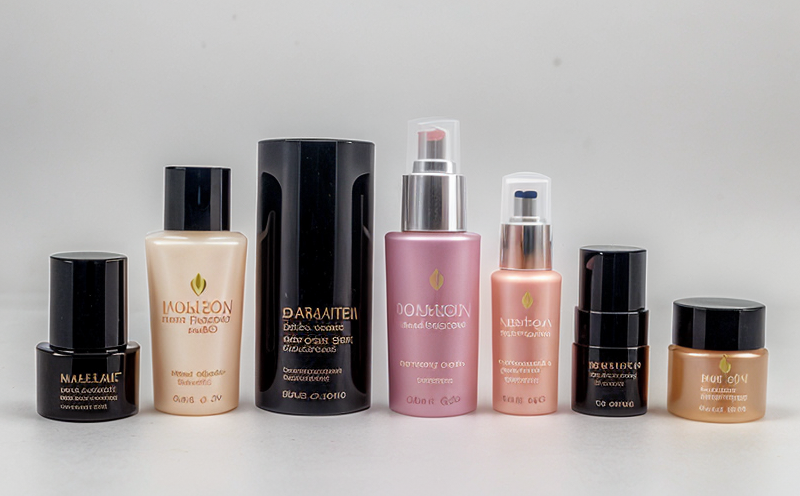Heavy Metal Migration Testing in Cosmetic Packaging
Introduction: Heavy metal migration testing is a crucial aspect of ensuring product safety and compliance with international regulations. In cosmetics, packaging materials can leach heavy metals such as lead (Pb), cadmium (Cd), mercury (Hg), arsenic (As), and chromium (Cr) into the content under certain conditions. These metals are toxic at high levels and their presence in cosmetic products can pose serious health risks.
The ISO 13975-1 and ASTM D2490 standards outline the methods for determining heavy metal migration from packaging into liquid products. These tests are essential to ensure that the levels of heavy metals do not exceed safe limits as set by regulatory bodies like the Federal Drug Administration (FDA) and Institute for Quality and Safety in Healthcare (IQSH).
The testing process involves exposing the packaging material, typically made from plastic or metal, to a solution that simulates real-world conditions. The leachate is then analyzed using sensitive analytical techniques such as Inductively Coupled Plasma Mass Spectrometry (ICP-MS). This method provides high sensitivity and accuracy in detecting even trace amounts of heavy metals.
For quality managers, this testing ensures adherence to stringent regulations and helps maintain the trustworthiness of their brand. Compliance officers can rely on these tests to avoid legal issues arising from product recalls or non-compliance fines. R&D engineers benefit by using test results to iterate and improve packaging design for safety and regulatory compliance.
When dealing with specific types of cosmetic products, such as lotions, serums, or lipsticks, it is important to consider the type of packaging used. For example, metal containers like tin cans may have higher risks of lead migration compared to plastic bottles. Understanding these nuances helps in selecting appropriate testing methodologies.
Sampling and specimen preparation are critical steps. The packaging material should be cut into pieces that closely represent real-world usage scenarios. For instance, a lipstick tube might need to be sliced at the point where it makes contact with the product inside. This ensures that any migration observed is due to the packaging itself rather than external factors.
The testing process involves exposing these samples to an aqueous solution under controlled conditions for a specified duration. The duration can vary depending on the type of product and regulatory requirements but typically ranges from 24 hours to several days. After exposure, the leachate is collected and analyzed using ICP-MS or similar techniques.
The results are then reported in terms of parts per million (ppm) for each heavy metal detected. Compliance with international standards such as ISO 13975-1 or ASTM D2490 ensures that the product meets regulatory requirements. These standards provide clear guidelines on acceptable levels of heavy metals in cosmetic products.
In summary, heavy metal migration testing is not just a compliance requirement but also an essential step towards ensuring consumer safety and maintaining brand reputation. It requires meticulous specimen preparation, controlled exposure conditions, and sophisticated analytical techniques to produce reliable results.
Eurolab Advantages
Expertise and Experience: Eurolab has over 15 years of experience in the field of cosmetic testing. Our team of experts includes chemists, toxicologists, and engineers who understand both the technical aspects of testing and the regulatory landscape.
- We offer state-of-the-art facilities equipped with advanced analytical instruments such as ICP-MS, GC-MS, and LC-MS/MS.
- Our laboratory is ISO 17025 accredited, ensuring that all tests are conducted to international standards.
- Eurolab follows strict quality control procedures to ensure the accuracy and reliability of our results.
Comprehensive Services: In addition to heavy metal migration testing, Eurolab provides a wide range of other cosmetic packaging tests. These include microbiological stability studies, allergen detection, and shelf life determination. Our comprehensive service offerings allow us to provide a one-stop solution for all your cosmetic packaging needs.
Prompt Turnaround Times: We understand the importance of timely results in the fast-paced world of product development and compliance. Eurolab prides itself on delivering reliable results within 7-10 working days, depending on the complexity of the test.
International Acceptance and Recognition
- ISO 13975-1:2018
- ASTM D2490-20
- EN 12766:2006
- EU Cosmetics Regulation (EC) No. 1223/2009, Annex I, Part III, Section II, Chapter 4
The testing of heavy metals in cosmetic packaging is governed by several international standards and regulations. These include ISO 13975-1:2018 for the determination of metal leaching from plastic materials into aqueous solutions, ASTM D2490-20 for the evaluation of metallic contamination in cosmetics, EN 12766:2006 for the assessment of metal migration from packaging, and the EU Cosmetics Regulation (EC) No. 1223/2009 which provides specific limits on heavy metals.
Adherence to these standards ensures that the results are internationally recognized and accepted by regulatory bodies worldwide. Laboratories that follow these guidelines can provide confidence in their testing capabilities, thereby enhancing market credibility.
Competitive Advantage and Market Impact
Innovation and Efficiency: By staying ahead of changing regulations and trends, Eurolab ensures that its clients remain competitive. Our expertise in heavy metal migration testing allows us to provide cutting-edge solutions tailored to each client's unique needs.
Reputation and Trust: A strong reputation is built on reliability and consistency. Eurolab's ISO 17025 accreditation, coupled with our long-standing experience, has established us as a trusted partner in the cosmetic industry. This trust translates into increased market share for our clients.
Sustainability: As sustainability becomes increasingly important, Eurolab offers testing services that help identify and mitigate environmental impacts associated with packaging materials. By using sustainable materials or reducing waste, companies can enhance their corporate social responsibility (CSR) profiles.





